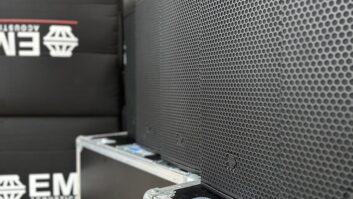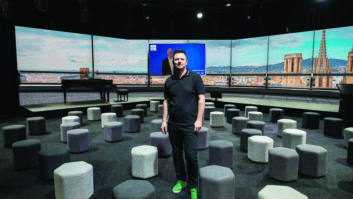 At the start of 2020, the AV industry was looking forward to another strong year. Growth in the market – and specifically in pro audio use among all types and sizes of end users – was trending in the right direction. Unfortunately, that changed when the world was impacted by the global pandemic.
At the start of 2020, the AV industry was looking forward to another strong year. Growth in the market – and specifically in pro audio use among all types and sizes of end users – was trending in the right direction. Unfortunately, that changed when the world was impacted by the global pandemic.
However, one positive thing to come out of the past year was a discovery of how and where pro audio can be a problem solver for institutions and firms of all shape and size. The beginning of the new year is often a time to reflect on the year that has just passed – and thus, we should look to what we learned over the past year and prepare for how we will frame and integrate solutions upon a return to normal’.
Now, what does ‘normal’ look like in the near-term and long-term? It’s a good question – and one we can begin to plan for by looking at current uses, challenges and demands in key installation verticals. When we give it a closer look, what we
find is a need for continued access to information, a demand for quality sound that impacts institutional outcomes, and an enablement of both hybrid setups and long-term fault tolerance.
That said, let’s look at the specifics of how this is being achieved – and consider how we improve it going forward.
Learning curve
Remote learning and ‘hybrid’ learning became mission critical over the past year for educational institutions from kindergarten to the university level. As the year progressed, pro audio
became more crucial in the effective application of these uses.
The hybrid model – where students are on-site and remote – specifically required unique AV solutions for moving audio around effectively in new locations that had never planned for live sound. In
some applications, large spaces were adapted into new classrooms – be they gymnasiums, multipurpose rooms, or even outdoor quads. This, of course, came with a challenge: how to make sure everyone could hear.
Systems that are both portable and provide specific tuning capabilities – typically digitally steerable loudspeaker offerings – became major enablers. With loudspeakers that employ digital beamsteering you can keep sound from reflecting around a room filled with reverberant surfaces – such as a gymnasium – and improve intelligibility of the spoken word. Digitally steerable solutions allow for the programming of a loudspeaker for a specific location, improving the general quality of the audio by placing sound precisely where you want it: on the audience.
This technology was also quickly adapted to a secondary hybrid use that is likely to stick around in the medium-term: overflow locations. By placing students across multiple learning spaces a school can maintain social distancing guidelines. And, with the correct AV integration, a single teacher can still instruct all of these students from a single space. Key again here is the sound. As long as the teacher can be heard and understood, the students can still take part in the class. Thus, intelligibility and quality of audio remain important in this setup as well.
These revised solutions also have a few long-term uses. First, they improve audio across the campus, regardless of how many individuals are in a room. Portable systems can quickly be repurposed as room occupancy changes. And, as studies have shown that student success is linked to the ability to effectively hear the teacher, this is an upgrade that makes sense for every institution.
However, these systems have another powerful benefit: they provide a form of long-term fault tolerance. If a situation arises again where our physical learning environments can’t be used as intended, we can plan to quickly pivot to one of these hybrid models.
In 2020, we were all caught by surprise when new health and safety measures demanded a change. We won’t have that happen again – and flexible AV systems mean an institution can swiftly adapt.
Church challenges
The house of worship market is discovering a unique challenge as it returns to in-person service: when it turns its sound system back on, the new remote video assets it has introduced suddenly sound unintelligible.
The house of worship market was one of the most effective adopters of new technology during 2020. Video streaming became a powerful tool to deliver the message to congregations. It was safe, effective, and many will keep the remote video asset as part of its worship offerings long term. However, while worshipers were away, there was no need to use the house audio – the feed went directly into the video streaming setup.
But with hybrid use, loudspeaker systems are being powered up again to accommodate those who are returning to in-person service. And as sound reflects around the often ornate and reverberant worship space, the audio mix on the video stream picks up a ton of noise.
What to do? An example of how to fix this was recently seen in Tulsa, Oklahoma, where Faith United Methodist Church upgraded to digitally steerable loudspeakers and ensured live sound was placed precisely on the in-person congregation. By programming the loudspeakers specifically for the worship space, the audio being projected to the in-person audience no longer interfered with the audio being picked up by the video feed. The church said that the change was noticed by remote viewers immediately, and was met with welcome appreciation.
This example ties back to concepts we’ve previously explored: continuing to provide high-quality audio access to all who want and need access, enabling a hybrid setup, and offering a fault tolerant system that is ready to adapt should the need again arise to social distance.
This is a solution that is very likely to be in demand in the coming months as houses of worship work to keep their streaming services up and running. It is a need integrators and manufacturers must understand, plan for, and offer a solution for.
Business benefits
Many of the benefits we’ve explored thus far will also apply to the corporate world, where the conference room maintains its place as an important component of daily work. Much as we saw with education, it is critical to provide overflow areas or adapt larger spaces to ensure no one who needs access is left out. As we saw with houses of worship, we need to enable a remote and hybrid setup that is intelligible for all participants. And again, the security provided by long-term fault tolerance is certainly key.
The corporate space can benefit from smaller format loudspeaker offerings that connect more locations across a facility. This is also an upgrade that can be tackled immediately – and should be presented with the key benefits we’ve discovered.
New normal
We’ve discussed it all above, however, it is important to reiterate a final time. As we return to the ‘normal’ we knew before 2020 we will see a demand for transitional, hybrid-use AV and for long-term solutions. This is important not just in the above verticals, but in installations across all types of use cases – including government, hospitality, retail and themed entertainment.
Connected ideas and needs:
Provide everyone access to the information an institution provides
• Offer quality sound that is intelligible and results in institutional success
• Enable hybrid setups where in-person and remote participants receive the same quality of sound
• Provide a fault tolerant offering that allows for a quick pivot in case the demand changes
We’ve outlined a solution that has worked for many institutions in digitally steerable loudspeakers. That said, there are also many distributed audio systems and video components worth looking at.
AV-over-IP integrations, specifically those that are implementing Audinate’s Dante, are also very important, as they allow for scalability and flexibility across many of these spaces. In fact, in all of these, a blend of offerings will likely be key to success.
The path ahead to success, then, is for system integrators to work closely with product manufacturers who are forecasting the needs ahead, offering solutions to those needs, and helping to communicate the key benefits to the end user.
In that way, we ensure everyone can hear and be heard – no matter what the year ahead throws at us.






